Yakovlev Yak-130
The Yakovlev Yak-130 (NATO reporting name: Mitten)[6] is a subsonic two-seat advanced jet trainer and light fighter originally developed by Yakovlev and Aermacchi as the "Yakovlev-Aermacchi Yak-130/AEM-130". It has also been marketed as a potential light attack aircraft. Development of the aircraft began in 1991 and the maiden flight was conducted on 25 April 1996. In 2002, it won a Russian government tender for training aircraft and in 2009 the aircraft entered service with the Russian Air Force. As an advanced training aircraft, the Yak-130 is able to replicate the characteristics of several 4+ generation fighters as well as the fifth-generation Sukhoi Su-57. It can also perform light-attack and reconnaissance duties, carrying a combat load of 3,000 kg.
| Yak-130 | |
|---|---|
.jpg) | |
| A Russian Air Force Yak-130 | |
| Role | Advanced trainer / Light fighter |
| National origin | Russia |
| Manufacturer | Irkut Corporation, Sokol Aircraft Plant |
| Design group | Yakovlev |
| First flight | 25 April 1996[1] |
| Introduction | 19 February 2010[2] |
| Status | Active |
| Primary users | Russian Air Force Algerian Air Force Bangladesh Air Force Belarusian Air Force |
| Number built | 150 as of 2019[3] |
| Unit cost | |
| Developed into | Alenia Aermacchi M-346 Master |
Development
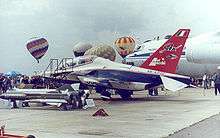
In the early 1990s, the Soviet government asked the industry to develop a new aircraft to replace the Czech-made Aero L-29 Delfín and Aero L-39 Albatros jet trainers. Five design bureaus put forward proposals. Among them were the Sukhoi S-54, Myasishchev M-200, Mikoyan MiG-AT, and Yakovlev Yak-UTS. In 1991, the other proposals were dropped and only the MiG-AT and Yak-UTS remained. The air forces of the newly independent Russia estimated that its requirement would be about 1,000 aircraft.[7]
Development of Yak-UTS started in 1991 and the design was completed in September 1993. With the collapse of the Soviet Union, however, Yakovlev was compelled to look for a foreign partner. After having entered discussions in 1992, in 1993 it agreed with the Italian company Aermacchi to jointly develop the plane, which now became Yak/AEM-130;[8] Aermacchi would be responsible for the project's financial and technical support.[9] The first prototype, dubbed Yak-130D, was built by Sokol at Nizhny Novgorod, Russia, and was publicly unveiled in June 1995.[10][11] The aircraft made its first flight on 25 April 1996 from Zhukovsky Airport at the hands of Yakovlev chief test pilot Andrey Sinitsyn.[12]
In 2000, differences in priorities between the two firms had brought about an end to the partnership, with each developing the aircraft independently. The Italian version was named M-346; Yakovlev received US$77 million for technical documents of the aircraft.[7] Yakovlev would be able to sell the aircraft to countries such those in the Commonwealth of Independent States, India, Slovakia and Algeria. Aermacchi would be able to sell to NATO countries, among others.[7]
In March 2002, Commander-in-Chief Vladimir Mikhailov said that the Yak-130 and the MiG-AT had been chosen as the Russian Air Force's new trainers.[7][13] The Yak-130, however, was said to be superior as it could serve the dual role of a trainer and combat jet.[14] On 10 April 2002, it was announced that Yak-130 had been chosen as the winner of the tender for trainer aircraft for basic and advanced pilot training, beating the MiG-AT.[15] By then, the Russian Air Force had ordered 10 Yak-130s, and the total cost of research and development, which included the construction and testing of the four pre-production aircraft, had amounted to some $200 million, 84% of which was financed by Yakovlev and the rest by the Russian government.[7][13] However, it was reported that as much as $500 million had been spent in as early as 1996.[1]
Plans to develop a light-attack aircraft based on the Yak-130 came to a halt in the late 2011. Dubbed Yak-131, the aircraft failed to meet critical pilot safety requirements put forward by the Russian Air Force.[16] The air force had instead shifted focus to a replacement based on the Sukhoi Su-25,[17] which was slated to enter service by 2020.[16]
Design
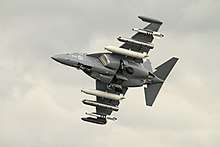
Yak-130 is an advanced pilot training aircraft, able to replicate characteristics of Russian 4th and 5th generation fighters.[18] This is possible through the use of open architecture digital avionics compliant with a 1553 Databus, a full digital glass cockpit, four-channel digital Fly-By-Wire System (FBWS) and Instructor controlled and variable FBWS handling characteristics and embedded simulation. The type also has a Head-up display (HUD) and a Helmet-Mounted-Sighting-System (HMSS), with a double GPS/GLONASS receiver updating an Inertial Reference System (IRS) for highly accurate navigation and precision targeting.[19] The developer estimates that the plane can cover up to 80% of the entire pilot flight training program.[20]
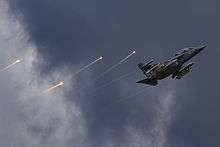
In addition to its training role, the aircraft is capable of fulfilling Light Attack and Reconnaissance duties.[18] It can carry a combat load of 3,000 kilograms (6,600 pounds), consisting of various guided and un-guided weapons, auxiliary fuel tanks and electronic pods.[20] According to its chief designer Konstantin Popovich, during a testing phase that ended in December 2009, the plane was tested with "all airborne weapons with a weight of up to 500 kg that are in service in the Russian Air Force".[18] Yak-130 has nine hard points: two wingtip, six under-wing and one under-fuselage.[19]

The aircraft's twin engines are mounted under extended wing roots, which reach as far forward as the windscreen. Two Ivchenko Progress AI-222-25 Full Authority Digital Engine Control (FADEC) produce a combined total of 49 kilonewtons (11,000 pound-force) of thrust. An upgraded, "-28" engine is also on offer, increasing the thrust to 53 kN (12,000 lbf). At a normal Take-Off Weight of 7,250 kg (15,980 lb), a Thrust-to-Weight ratio of 0.70 is achieved with the "-25", or 0.77 with the "-28" engines. This compares with 0.65 for the BAE Systems Hawk 128 and 0.49 for the Aero Vodochody L-159B.[19]
Maximum internal fuel capacity is 1,700 kg (3,700 lb). With two external combat fuel tanks the figure increases to 2,600 kg (5,700 lb). Maximum true airspeed is Mach 0.93 (572 knots), service ceiling is 12,500 metres (41,000 feet) and load factors are from −3 to +9 g. Typical Take-Off speed and distance in a "clean" configuration are 209 km/h (113 kn) and 550 m (1,800 ft), whilst landing figures are 191 km/h (103 kn) and 750 m (2,460 ft), respectively. Cross wind limit is 56 km/h (30 kn).[19]
The Yakovlev Yak-130 is equipped with the FBWS controlled engine intake blanking doors, in order to prevent the aircraft's engines from sustaining Foreign object damage when operating from unpaved runways and grass strips.[21]
The large canopies are sideways hinged.
Combat training suite on the Yak-130 includes simulated and real firing systems with air-to-air and air-to-surface missiles, bomb dropping, gun firing and on-board self-protection systems.
Operational history
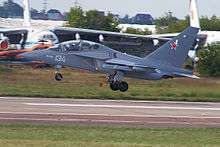
Yak-130 prototype completed its maiden flight, registered as RA-43130, on 25 April 1996 at Zhukovsky airfield.
On 30 April 2004, the first pre-series Yak-130, assembled at the Sokol plant in Nizhny Novgorod, performed its maiden flight.[2] The plane was put on display for the first time at the Paris Air Show in June 2005.[15] It was followed by three more pre-series aircraft.
In December 2009, the aircraft completed state trials and was accepted for service in the Russian Air Force.
Accidents and incidents
- 26 June 2006: A Yak-130 prototype crashed in the Ryazan region. Both pilots ejected safely without injuries.[22]
- 29 May 2010: A preseries Yak-130 crashed in the center of Lipetsk combat training and retraining of personnel. The accident occurred during testing. Both pilots ejected; their condition was satisfactory. There were no casualties or injuries to people on the ground.[23][24]
- 15 April 2014: A Yak-130 crashed in the Astrakhan region, 25 km. from Akhtubinsk near the village Bataevka. The crew of two pilots ejected, one of the pilots died – Air Force Lt. Col. Sergei Seregin. The cause of the disaster was a malfunction. The Yak-130 was owned by 1080th Red Banner Aviation Centre for Retraining of Personnel named V.P. Chkalov at Borisoglebsk. There were no casualties or damage to those on the ground.[25]
- 11 July 2017: A Bangladesh Air Force Yakovlev Yak-130 'Mitten' training aircraft crashed at Lohagara in Bangladesh’s southeastern Chittagong District.[26] Two pilots were unharmed.[27]
- 16 November 2017: A Russian Air Force Yak-130 crashed near the Borisoglebsk airbase, the ministry said in a statement. The crew of the plane avoided hitting nearby buildings before ejecting safely, according to the ministry.[28]
- 27 December 2017: Two Bangladesh Air Force Yakovlev Yak-130 aircraft crashed at Maheshkhali Island in Cox's Bazar due to a mid-air collision. The official report states that the accident happened during the breaking of formation at a training exercise. All four pilots of two aircraft were rescued alive.[29][30]
Orders and deliveries
In 2005, Russian Air Force made its first order for 12 Yak-130s. The Russian Air Force intends to buy at least 72 Yak-130s, enough to equip four training regiments.[31] Commander-in-Chief, Colonel General Aleksandr Zelin, announced on 8 November 2011, that the Russian Defence Ministry was to sign a contract within two weeks with Irkut Corporation for 65 additional aircraft[32] – 55 firm orders plus 10 options.[19] Zelin stated that deliveries were expected to be completed by 2017.[32]
The first serial aircraft was handed to a training center in Lipetsk on 19 February 2010.[2] Once the 2005 contract for 12 Sokol plant-made Yak-130s for the Russian Defence Ministry was fulfilled in June 2011, a decision was made that all subsequent Yak-130 orders, both domestic and export ones, would be handled by the Irkutsk Aviation Plant of the Irkut Corporation.[33] However, the Russian Air Force only took delivery of the first Yak-130 by the Irkutsk in October 2012.[34] "The first batch of Yak-130 combat trainers flew from the Irkut plant to the Borisoglebsk airfield, after an extensive flight testing program", stated Colonel Andrei Bobrun.[35]
In February 2014 Irkut Corporation revealed a contract with the Russian Ministry of Defense (MoD) to supply additional Yakovlev Yak-130 advanced jet trainer aircraft to the National Air Force. According to Irkut president Oleg Demchenko, the company in December signed a contract with the Defense Ministry on the delivery of 12 Yak-130 aircraft to form a new aerobatics team.[36][37] At the same time, second contract occurred to be signed for 10 more aircraft, for the Russian Naval Aviation.
In April 2012, Irkut Corporation president, Alexey Fedorov claimed that there are "more than ten potential customers".[38]
In November 2012, Sergey Kornev, a representative of the Rosoboronexport (Russia's state intermediary agency for exports/imports of defense-related products) said Malaysia and several other countries are also interested of Yak-130. He was speaking at the China Airshow 2012 in the Chinese city of Zhuhai.[39]
In December 2012, Government of Belarus signed an agreement with Russia to provide four Yak-130 to Belarus by 2015.[40] Belarus has ordered new combat aircraft from Russia, according to the commander of Belarus' Air Force and Air Defense Forces in August 2015. Major General Oleg Dvigalev said the country has signed two contracts for four Russian Yakovlev Yak-130 Mitten trainer/strike aircraft.[41] A further 4 aircraft were delivered in 2019, bringing the total up to 12 aircraft. All were delivered to 206th Flight Training Centre.[42]
Libya put an order for 6 planes. Deliveries to Libya were expected in 2011–2012,[18] but the Libyan National Transitional Council cancelled Libya's order for Yak-130s in September 2011 as part of a review of all existing arms contracts.[43]
Syria has agreed to purchase 36 aircraft,[44] but delivery of these has been postponed by Russia due to the conflict in Syria.[45] In May 2014 Russia announced that it will supply Syria with Yakovlev Yak-130 advanced jet trainer aircraft. Syria was expected to receive nine aircraft by the end of 2014, twelve in 2015 and fifteen in 2016, for overall of 36 airplanes.[46][47]
.jpg)
In January 2014, Bangladesh ordered 24 Yak-130s. The aircraft are bought with an extended loan from Russia.[48] Later the order has been reduced to 16 aircraft.[49] First batch of 6 aircraft was delivered on 20 September 2015.[50] Second batch of 5 aircraft was delivered on 29 December 2015 while next 5 were delivered by the first quarter of 2016.
The Uruguayan Air Force is considering the aircraft for the future replacement of the A-37[51] with the F-5 Freedom Fighter as another possible candidate.[52]
Russia has offered the Yak-130 to Serbia as part of a US$3 billion loan for the upgrading of the Serbian Armed Forces.
Variants
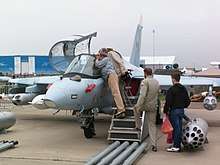
- Yakovlev Yak-130
- Basic dual seat advanced trainer.
- Yakovlev Yak-131
- Light attack aircraft as the Su-25 replacement.[53] This version will have cockpit and engine armour, a GSh-30-1 autocannon, and either the Phazotron Kopyo radar with mechanical or electronic beam scanning, or the Tikhomirov NIIP Osa passive phased array radar [54]
- Yakovlev Yak-133
- Light Strike Aircraft for LUS. The project was canceled in the early 1990.
- Yak-133IB
- Fighter bomber.[55]
- Yak-133PP
- Electronic countermeasure platform.[55]
- Yak-133R
- Tactical reconnaissance variant.[55]
- Yakovlev Yak-135
- Four seat VIP transport.[55]
Operators
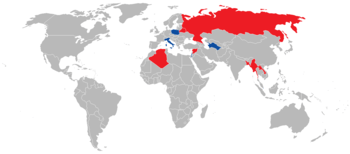
- Algerian Air Force – 16 aircraft in service.[56]
- Bangladesh Air Force – 16 aircraft in service.[57]
- Belarusian Air Force – 12 aircraft in service.[58] In June 2019, a contract was signed with Irkut Corporation to retrofit the Yak-130 aircraft for the installation of the Belarusian-made Talisman airborne defensive suite.[59]
- Lao People's Liberation Army Air Force – 10 aircraft on order, 4 in service.[60][61][62]
- Myanmar Air Force – 18 aircraft in service.[63] First contract was signed in 2015, first 3 aircraft of the contract were delivered in March 2017.[64] Another 3 aircraft under the first contract were delivered in November 2017, increasing the total number of aircraft in service to 6.[65] In February 2018, it was announced Myanmar will receive another batch of 6 aircraft under the second contract signed in December 2016, the aircraft were delivered in late 2018.[66][67][68] 6 more commissioned in December 2019.[69]
- Russian Air Force – 105 aircraft out of 109 delivered in service as of 2018.[70][71][72][73] The Russian Air Force placed a firm order for 55 aircraft in December 2011, with a delivery deadline by 2015. In December 2013, two new contracts were signed for a total delivery of 22 aircraft, with 12 aircraft to be delivered to Russia's aerobatic team.[74][36] A new contract for 30 aircraft was signed in April 2016.[75] Russia has a total requirement for about 200 aircraft.[76] A new contract signed in 2019 and the first 2 aircraft delivered in early 2020.[77]
- Syrian Air Force – 36 aircraft on order. Deliveries postponed due to the ongoing Syrian Civil War.[78]
- Vietnam People's Air Force – at least 12 aircraft on order.[79]
Specifications (Yak-130)
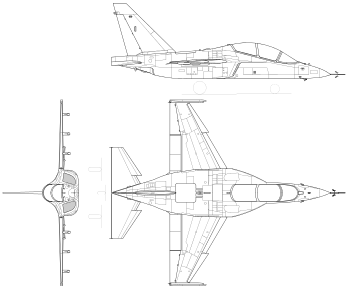
Data from YAK-130[80]
General characteristics
- Crew: 2
- Length: 11.49 m (37 ft 8 in)
- Wingspan: 9.84 m (32 ft 3 in)
- Height: 4.76 m (15 ft 7 in)
- Wing area: 23.52 m2 (253.2 sq ft)
- Empty weight: 4,600 kg (10,141 lb)
- Gross weight: 7,250 kg (15,984 lb)
- Max takeoff weight: 10,290 kg (22,686 lb)
- Powerplant: 2 × Ivchenko-Progress AI-222-25 turbofan engines, 24.52 kN (5,510 lbf) thrust each
Performance
- Maximum speed: 1,060 km/h (660 mph, 570 kn)
- Cruise speed: 887 km/h (551 mph, 479 kn)
- Stall speed: 165 km/h (103 mph, 89 kn)
- Range: 2,100 km (1,300 mi, 1,100 nmi)
- Combat range: 555 km (345 mi, 300 nmi) [81]
- Service ceiling: 12,500 m (41,000 ft)
- g limits: +8.0 −3.0
- Rate of climb: 65 m/s (12,800 ft/min)
- Wing loading: 276.4 kg/m2 (56.6 lb/sq ft)
- Thrust/weight: 0.70[82]
Armament
- Hardpoints: 9 (1 on each wingtip, 3 under each wing, and 1 under the fuselage)[19] with a capacity of up to 3,000 kg (6,614 lb),
See also
Related development
Aircraft of comparable role, configuration and era
References
Notes
- Taverna, Michael (1 June 1996). "Russian-Italian trainer programme back on course". Interavia Business & Technology. ISSN 1423-3215. Archived from the original on 24 September 2015. Retrieved 22 August 2015 – via HighBeam Research.
- Piotr Butowski, Jakowlew Jak-130 wszedł do służby w Rosji in: Lotnictwo Nr. 4/2010, p.10 (in Polish)
- https://www.ainonline.com/aviation-news/defense/2020-02-03/vietnam-places-order-yak-130-trainers
- http://www.armstrade.org/includes/periodics/news/2012/0214/143511603/detail.shtml
- https://ria.ru/20120210/561910973.html
- Parsch, Andreas; Aleksey V. Martynov (2008). "Designations of Soviet and Russian Military Aircraft and Missiles". Designation-Systems.net. Archived from the original on 11 October 2017. Retrieved 13 April 2010.
- Butowski, Piotr (1 May 2002). "Russian military trainer strategy falls into place; the selection of the Yak-130 marks an important step towards replacing the country's aging fleet of L-39Cs. Things are moving in the simulator business, too". Interavia Business & Technology. ISSN 1423-3215. Archived from the original on 24 September 2015. Retrieved 22 August 2015 – via HighBeam Research.
- "Italy Joins Yak-130". Aviation Week & Space Technology: 60. 28 June 1993.
- Moxon, Julian (7–13 August 1996). "Aermacchi proves Yak-130/AEM performance". Flight International: 18. Archived from the original on 19 July 2018. Retrieved 19 July 2018.
- Velovich, Alexander (7–13 June 1995). "Yakovlev rolls out Yak-130". Flight International: 20.
- Penney, Stewart (10–16 June 2003). "Agile Design". Flight International: 94. Archived from the original on 19 July 2018. Retrieved 19 July 2018.
- "Yak-130 – Combat Trainer of New Century". Take-Off: 30–39. June 2005.
- Pronina, Lyuba (1 April 2002). "MiG, Yak to Split Training Craft Deal". The Moscow Times. Archived from the original on 24 September 2015. Retrieved 22 August 2015 – via HighBeam Research.
- Pronina, Lyuba (8 April 2002). "French Tout MiG-AT Partnership". The Moscow Times. Archived from the original on 24 September 2015. Retrieved 22 August 2015 – via HighBeam Research.
- "Yakovlev Yak-130 (Russian Federation), Aircraft – Fixed-wing – Civil/military". Jane's All the World's Aircraft. 20 July 2010.
- "Russia to Field New Ground Attack Jet". RIA Novosti. Archived from the original on 20 May 2012. Retrieved 17 June 2012.
- Hoyle, Craig (10 July 2012). "IN FOCUS: United Aircraft's sky-high ambitions". Flightglobal. Archived from the original on 23 December 2015. Retrieved 23 December 2015.
- Pyadushkin, Maxim (16 February 2010). "Reprogrammed Trainer – Yak-130 jet trainer is cleared for service". Russia & CIS Observer. Archived from the original on 28 July 2011. Retrieved 11 September 2010.
- Collins, Peter (10 July 2012). "FLIGHT TEST: Yak-130 proves versatility". Flighglobal. Archived from the original on 4 March 2016. Retrieved 23 December 2015.
- "Yak-130". United Aircraft Corporation. Archived from the original on 3 October 2011. Retrieved 1 November 2011.
- Hoyle, Craig (11 July 2012). "FARNBOROUGH: Yak-130's engine intakes cause confusion". Flightglobal. Archived from the original on 23 December 2015. Retrieved 23 December 2015.
- В Рязанской области разбился учебно-боевой самолет Як-130 из подмосковного Жуковского Archived 16 November 2014 at the Wayback Machine. NEWSru.com (26 July 2006). Retrieved on 30 June 2018.
- Russia investigates cause of Yak-130 crash Archived 4 June 2010 at the Wayback Machine. Flightglobal.com (26 June 2018). Retrieved on 2018-06-30.
- В Липецке упал самолет ВВС РФ ЯК-130 – РИА Новости, 29.05.2010 Archived 29 November 2010 at the Wayback Machine. Rian.ru (29 May 2010). Retrieved on 2018-06-30.
- Plane crash near Astrakhan: Yak-130 crashed due to technical problems Archived 28 October 2014 at the Wayback Machine. Volgograd.kp.ru (15 April 2014). Retrieved on 30 June 2018.
- "Bangladesh Air Force training aircraft crashes in Chittagong". IHS Jane’s. Archived from the original on 11 July 2017. Retrieved 11 July 2017.
- "Bangladesh Air Force training aircraft crashes in Chittagong, pilots unharmed". bdnews24.com. Retrieved 12 July 2017.
- Sputnik. "Yak-130 Trainer Jet Crashes Near Airfield in Central Russia, Pilots Eject". sputniknews.com. Archived from the original on 16 September 2017. Retrieved 18 September 2017.
- "Accident involving two training jets of Air Force reported in Cox's Bazar". Bdnews24.com. 27 December 2017. Archived from the original on 27 December 2017. Retrieved 27 December 2017.
- "2 BAF training aircrafts [sic] crash in Cox's Bazar, 4 pilots rescued". The Daily Star. 27 December 2017. Archived from the original on 27 December 2017. Retrieved 27 December 2017.
- Author: Marcel van Leeuwen "YAK-130 delivery goes hand in hand with Russian training overhaul | INTERNATIONAL AVIATION NEWS". Aviationnews.eu. 4 March 2010. Archived from the original on 30 September 2011. Retrieved 17 October 2011.
- "Russia to order 65 more Yak-130s". Air Forces Monthly (286): 28. January 2012.
- Author:Mikhail Suntsov Cadets learning to fly on Yak-130 Archived 12 October 2014 at the Wayback Machine journal Take-off, 12 April 2013
- "PICTURES: Russian air force receives first Yak-130 combat trainers". Flightglobal. Archived from the original on 14 December 2012. Retrieved 9 October 2012.
- "Russian Air Force Accepts First Yak-130". Sputnik. 4 October 2012. Archived from the original on 23 December 2015. Retrieved 23 December 2015.
- "New Russian Air Force Stunt Team to Have 12 Yak-130 Jets". Sputnik (news agency). 11 February 2014. Archived from the original on 7 July 2018. Retrieved 7 July 2018.
- "Irkut to supply additional Yak-130 trainers to Russian Air Force". 13 February 2014. Archived from the original on 22 February 2014. Retrieved 14 February 2014.
- "More than 10 nations considering Yak-130, says Irkut boss". Flightglobal. Archived from the original on 29 April 2012. Retrieved 23 April 2012.
- "Bangladesh wants to buy Russia's Yak-130 aircraft : Voice of Russia". 15 November 2012. Archived from the original on 11 March 2013. Retrieved 20 December 2012.
- "Russia to Deliver Four Warplanes to Belarus in 2015". Sputnik. 18 December 2012. Archived from the original on 23 December 2015. Retrieved 23 December 2015.
- "Belarus Air Force Boosts Orders of Ultra-Modern Russian Yak-130 Jets". Sputnik. 13 August 2015. Archived from the original on 18 December 2015. Retrieved 23 December 2015.
- "Archived copy". Archived from the original on 14 May 2019. Retrieved 14 May 2019.CS1 maint: archived copy as title (link)
- "New Libyan Government Cancels Russian Arms Deals". Air International, Vol 81 No 5, November 2011. p. 11.
- Russland verkauft Syrien 36 Militärflugzeuge Archived 6 May 2014 at the Wayback Machine Tages Anzeiger.
- "Russia Prods Syria's President Assad With Message of Growing Impatience". nytimes.com. 9 July 2012. Archived from the original on 9 July 2012. Retrieved 10 July 2012.
- Syria: new Yak-130 trainer aircraft to arrive from Russia this year. World Aeronautical Press Agency (5 May 2014).
- Report: Russia to send first batch of Yak-130 jets to Syria Archived 5 May 2014 at the Wayback Machine. Al Arabiya English (5 May 2014). Retrieved on 2018-06-30.
- Bangladesh Buys Russian Combat Training Jets Worth $800M – Sputnik International Archived 31 January 2014 at the Wayback Machine. En.ria.ru (28 January 2014). Retrieved on 2018-06-30.
- ЦАМТО / Новости / ВВС Бангладеш получили первую партию УБС Як-130 Archived 8 October 2015 at the Wayback Machine. Armstrade.org. Retrieved on 30 June 2018.
- "First Yak-130s arrive in Bangladesh". IHS Janes 360. Archived from the original on 10 January 2016. Retrieved 29 December 2015.
- "Uruguay MoD to publish future combat aircraft RfP". Dmilt.com. 8 August 2010. Archived from the original on 22 March 2012. Retrieved 17 October 2011.
- Uruguay; Air force mulls Russian YaK-130 procurement Archived 20 December 2013 at the Wayback Machine – Dmilt.com, 19 December 2013
- NEWS RUSSIAN AIR FORCE TO ORDER SU-25 REPLACEMENT Russian air force to order Su-25 replacement Archived 20 February 2016 at the Wayback Machine. Flightglobal.com (21 May 2012). Retrieved on 2018-06-30.
- Yak-130 makes first appearance Archived 2 March 2016 at the Wayback Machine. Flightglobal.com (17 June 2003). Retrieved on 2018-06-30.
- Yak-130 – Program Archived 5 February 2016 at the Wayback Machine. Globalsecurity.org. Retrieved on 30 June 2018.
- About the FlightGlobal Group | AirSpace Announcement Archived 9 May 2013 at the Wayback Machine. flightglobal.com (30 June 2016). Retrieved on 2018-06-30.
- "Bangladesh Air Force to get 16 Yak-130 soon". Newage.com. Archived from the original on 2 January 2015. Retrieved 31 December 2014.
- Fediushko, Dmirtry (14 May 2019). "Belarus receives four more Yak-130 aircraft". Jane's 360. Minsk. Archived from the original on 14 May 2019. Retrieved 14 May 2019.
- https://www.mil.by/en/news/88455/
- "В Лаос будет поставлено десять самолетов Як-130". bmpd.livejournal.com. 16 January 2019. Retrieved 16 January 2019.
- Fediushko, Dmitry (15 January 2019). "Update: Laos receives Yak-130s from Russia". Jane's 360. Moscow. Archived from the original on 15 January 2019. Retrieved 15 January 2019.
- "Russian military delegation to attend celebrations marking 70th Anniversary of the Lao People's Army Founding Day". mil.ru. 15 January 2019. Archived from the original on 15 January 2019. Retrieved 16 January 2019.
- http://www.armstrade.org/includes/periodics/news/2019/1218/125555888/detail.shtml
- "Russia Supplies to Myanmar First Three Yak-130 Combat Trainers". Sputnik (news agency). 21 March 2017. Archived from the original on 30 June 2018. Retrieved 7 July 2018.
- "Russia delivers six Yak-130 combat trainers to Myanmar". TASS. 8 November 2017. Archived from the original on 30 June 2018. Retrieved 7 July 2018.
- Davis, Anthony (8 February 2018). "Myanmar Air Force to receive more Yak-130 aircraft". IHS Jane's 360. Bangkok. Archived from the original on 9 February 2018. Retrieved 9 February 2018.
- "Russia to Deliver 6 Additional Yak-130 Aircraft to Myanmar". Sputnik News. Singapore. 7 February 2018. Archived from the original on 9 February 2018. Retrieved 9 February 2018.
- https://bmpd.livejournal.com/3496777.html
- https://www.janes.com/article/93235/myanmar-air-force-commissions-10-new-aircraft-to-boost-counter-insurgency-capabilities
- "Russian Air Force receives three more Yak-130 advanced trainer jets". airrecognition.com. 28 June 2017. Archived from the original on 30 June 2018. Retrieved 7 July 2018.
- "ВКС России получили еще четыре самолета Як-130". bmpd.livejournal.com. 18 June 2018. Retrieved 19 October 2018.
- "ВКС России получили еще три самолета Як-130". bmpd.livejournal.com. 31 July 2018. Retrieved 19 October 2018.
- "ВКС России получили очередные три самолета Як-130". bmpd.livejournal.com. 12 October 2018. Retrieved 19 October 2018.
- "Новые самолёты Як-130 и Су-30СМ для ВВС". sdelanounas.ru. 29 August 2014. Archived from the original on 30 June 2018. Retrieved 7 July 2018.
- "Russian air force orders more Yak-130 trainers". Flight Global. 19 April 2016. Archived from the original on 17 January 2018. Retrieved 7 July 2018.
- "Sokol starts deliveries of Yak-130 combat trainers to Russian AF". Sputnik (news agency). 13 August 2009. Archived from the original on 7 July 2018. Retrieved 7 July 2018.
- https://bmpd.livejournal.com/3932200.html
- "Russia to deliver Yak-130 trainers to Syria". Flight Global. 6 May 2014. Archived from the original on 22 September 2015. Retrieved 7 July 2018.
- "Vietnam Orders $350M Combat Training Jets From Russia – Vedomosti". The Moscow Times. 29 January 2020. Retrieved 16 March 2020.
- "A.S.Yakovlev design bureau –:– programs –:– new –:– Yak-130". www.yak.ru. Archived from the original on 31 December 2006. Retrieved 7 October 2019.
- "Yakovlev / Aermacchi Yak-130 Basic and advanced trainer". www.military-today.com. Archived from the original on 11 March 2016. Retrieved 7 October 2019.
- COLLINS, PETER. "FLIGHT TEST: Yak-130 proves versatility". Flightglobal.com. Flight. Retrieved 7 October 2019.
Bibliography
- Butowski, Piotr. "Russian T-Bird". Air International, Vol. 83 No. 3, September 2012. pp. 92–95. ISSN 0306-5634.
- Gunston, Bill. Yakovlev Aircraft since 1924. London, UK: Putnam Aeronautical Books, 1997. ISBN 1-55750-978-6.
The initial version of this article was based on material from aviation.ru. It has been released under the GFDL by the copyright holder.
External links
| Wikimedia Commons has media related to Yakovlev Yak-130. |